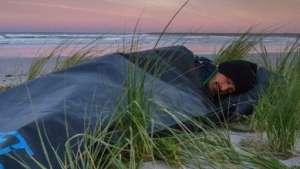From the Series
Refugee Republic is an interactive multimedia documentary about everyday life in Domiz camp, which houses Syrian refugees in Northern Iraq. But rather than a self-contained film, it exists as an interactive website with a detailed, hand-drawn map of the camp, audio recordings, film, photography, sound and text that come together to bring the everyday existence of the camp’s inhabitants to life.
Dutch artist Jan Rothuizen spent a week in Domiz in 2014 with photographer Dirk-Jan Visser and journalist Martijn van Tol, who recorded audio files documented life in the camp.
“I was curious to represent a refugee camp as I experienced it,” says Rothuizen, “not to show the camp as a passive place full of victims who need our help but to show it as a vibrant and developing city eager to grow. I felt there was (besides the sadness) also an eagerness and strength to think forward.”
Domiz camp is home to about 64 000 people, most of them Syrian Kurds. The camp has existed for over two years and has been developed by its inhabitants from the ground up: it now has its own baker, building supplier and other small businesses.
Visitors to the Refugee Republic site can move around the map and pause to zoom in and listen to the recordings of various residents telling their stories. Some of these stories also include illustrations by Rothuizen.
For example, you’ll meet Ahmed Ramadan, “The Truant”: 13 years old, he sells caged birds for five euros each (including the cage). You’ll learn that Ahmed remembers life on the farm in Syria where his father looked after the owner’s chickens and he kept birds as pets. The goldfinch is his favourite because of its beautiful song. His family fled to Iraq after the war. The relief workers keep asking Ahmed to come to school, but he is the only one who can help his father make a living. Plus, the Kurdish love birds.
There is also Ahmet Pashew, “The Holiday Maker”, who has been granted refugee status in the Netherlands. He came to Domiz to visit his family, who immediately found him a wife. She found herself a wedding dress in a bridal shop within the camp.
Shixmous Kalil, 60 years old, is the camp’s busy “Circumciser”. During his two years at the camp he has circumcised hundreds of boys. He doesn't charge the poorer families and he buries the cut-off skin in the ground.
“I am interested in things that are important,” says Rothuizen. “There are now NGOs that are very interested in doing similar things for their cause. But I think for me it was very important to be in this place without an agenda. I didn’t have to sell somebody else’s misery to raise money for example. I was really, in that sense, free.”
Rothuizen is known for creating what he calls “soft maps” that include subjective information, which he draws by hand with a fountain pen.
His work with refugees began on home soil with drawings and portraits of refugees in a detention centre for illegal immigrants at Schiphol Airport, Amsterdam’s main international airport.
Rothuizen trained as a painter, but he is most inspired when wandering the streets and making observations. He documents the world in journalistic drawings that have an element of storytelling to them and convey his unique ability to extract quirky details.
Through touching and often amusing stories of Domiz, the artist shows the resilience and resourcefulness of humans, and the strong link between humour and empathy.
“I am not trained as a journalist and I think as an artist I can show things in a different way to a journalist, who would be obliged to pretend to be objective,” says Rothuizen.
“It is interesting to play with different levels of information. There is the hard information: the facts, like the amount of people. But on the other hand there is the information that is more subjective. And that’s my interpretation, or the things that people tell me. The combination of the different ways of telling is interesting. That also involves humour. But I think the world is funny when you really look at it.”















